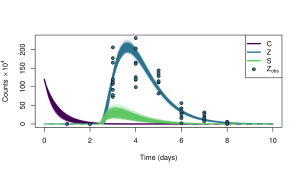
BOERSCH-SUPAN, RYAN – deBInfer: Bayesian inference for dynamical models of biological systems in R
Philipp H. Boersch-Supan, Sadie J. Ryan, Leah R. Johnson
Article first published online: 15 OCT 2016 Methods in Ecology and Evolution
DOI: 10.1111/2041-210X.12679
ABSTRACT:
1.Understanding the mechanisms underlying biological systems, and ultimately, predicting their behaviours in a changing environment requires overcoming the gap between mathematical models and experimental or observational data. Differential equations (DEs) are commonly used to model the temporal evolution of biological systems, but statistical methods for comparing DE models to data and for parameter inference are relatively poorly developed. This is especially problematic in the context of biological systems where observations are often noisy and only a small number of time points may be available.
2.The Bayesian approach offers a coherent framework for parameter inference that can account for multiple sources of uncertainty, while making use of prior information. It offers a rigorous methodology for parameter inference, as well as modelling the link between unobservable model states and parameters, and observable quantities.
3.We present deBInfer, a package for the statistical computing environment R, implementing a Bayesian framework for parameter inference in DEs. deBInfer provides templates for the DE model, the observation model and data likelihood, and the model parameters and their prior distributions. A Markov chain Monte Carlo (MCMC) procedure processes these inputs to estimate the posterior distributions of the parameters and any derived quantities, including the model trajectories. Further functionality is provided to facilitate MCMC diagnostics, the visualisation of the posterior distributions of model parameters and trajectories, and the use of compiled DE models for improved computational performance.
4.The templating approach makes deBInfer applicable to a wide range of DE models. We demonstrate its application to ordinary and delay DE models for population ecology.
Read the full publication at Methods in Ecology and Evolution